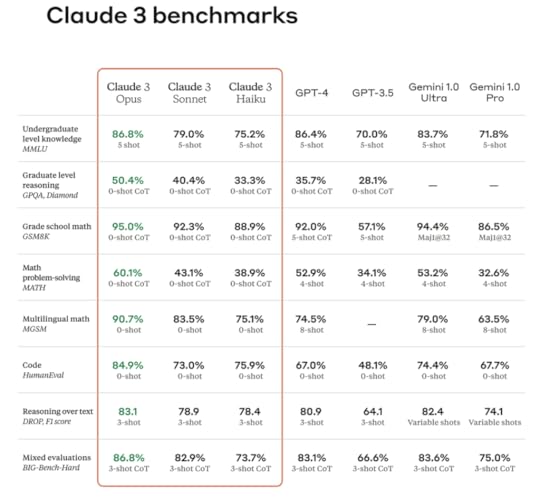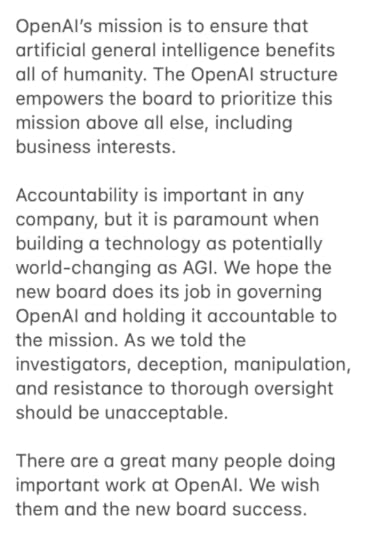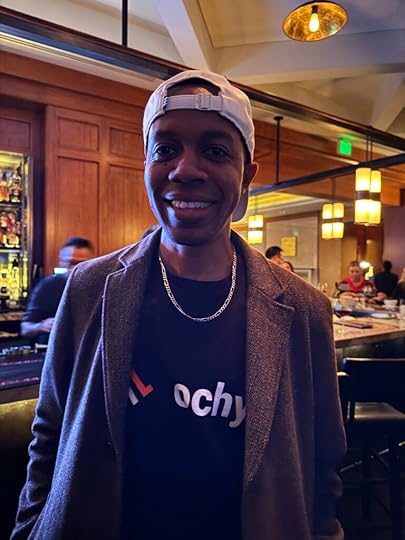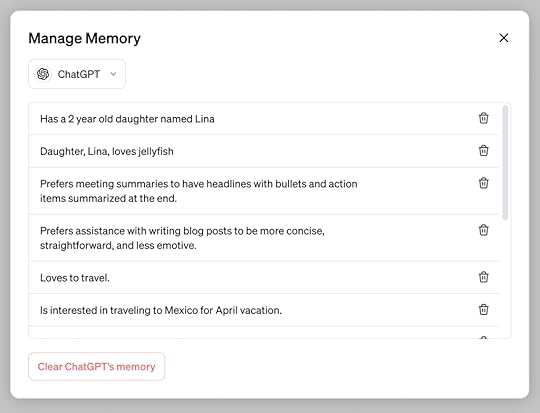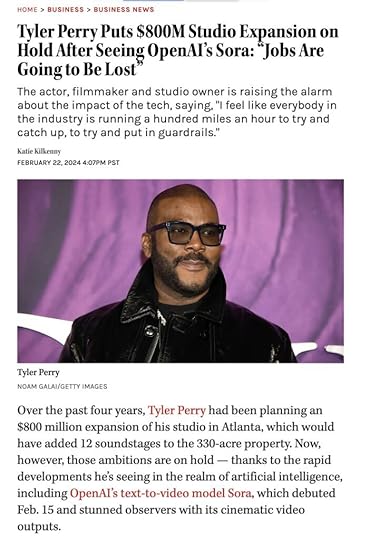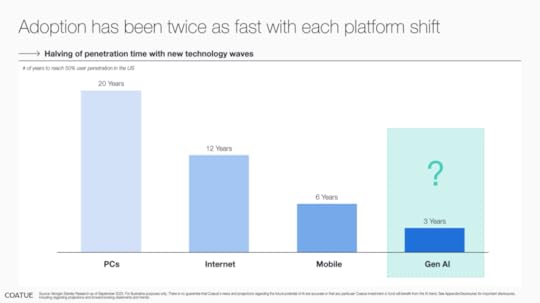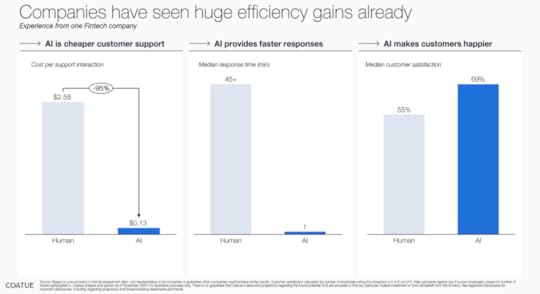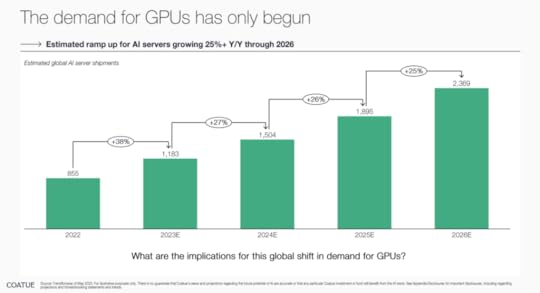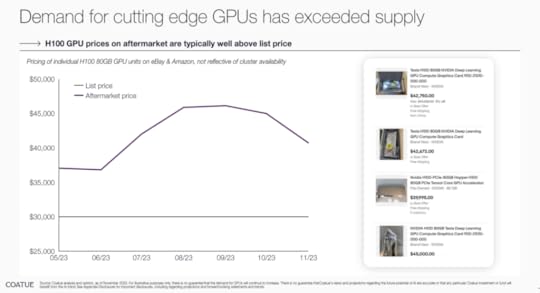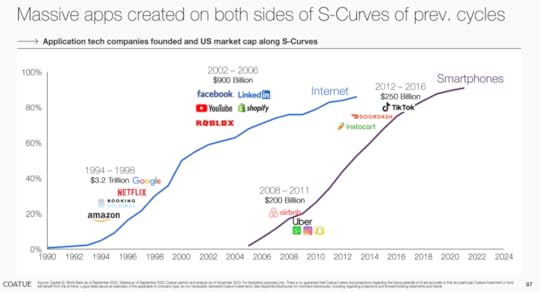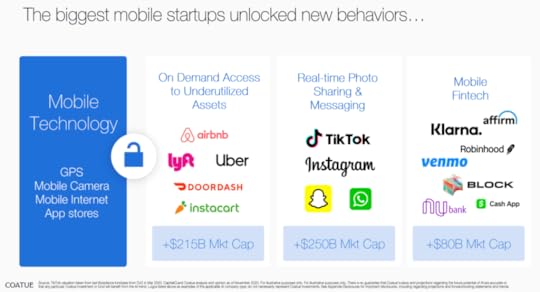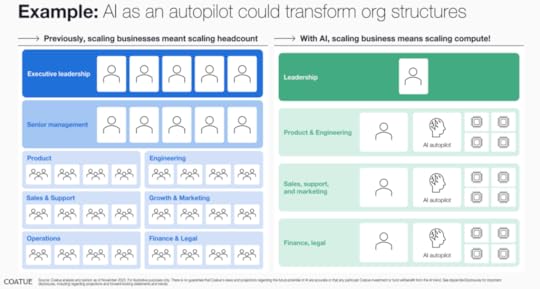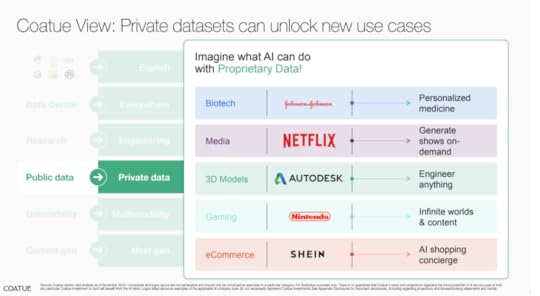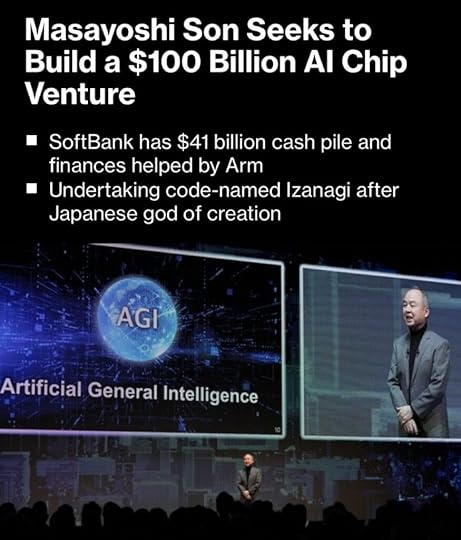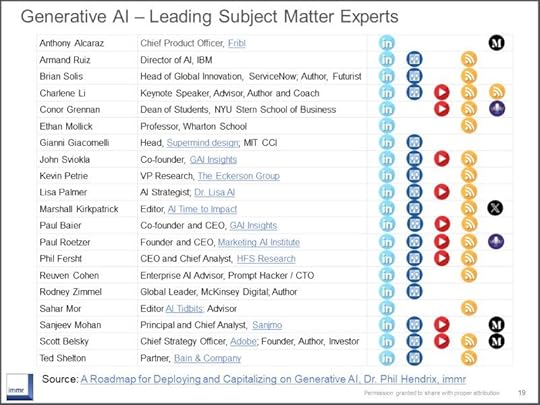Brian Solis's Blog, page 16
March 18, 2024
Lessons Learned, Advice I Would Give Myself and Probably Ignore, and the Skills I’m Learning to Unlock the Next Phase of My Career
For those of you who followed my work over the years, thank you. 
I’ve always been reluctant to pull the curtain back to tell my story. Honestly, I have a hard time talking about myself, even if it’s personal. I open up more about this in the video/links below…
My friends Nathalie Nahai and Dr. Aaron Balick launched a new community, “Time To Show Up,” to help professionals reconnect with their values, creative drive and personal mission.
I was asked if I would share my story.
I’ve shared a glass of wine or two at conferences around the world with them. I trust them. So, I said OK.
Here is that conversation. And it’s personal, raw, and honest. 

We cover a lot of ground. It’s the longest interview I’ve made time for in years, and hopefully you’ll see why.
Some of the key themes we explore include:
1. Authenticity and empathy are key in connecting with others and building meaningful relationships.
2. Balancing performance and genuine connection is a challenge in the digital world.
3. Adapting and changing are necessary to reach and resonate with people in a fast-paced and noisy environment.
4. Creativity and taking risks are essential in building a fulfilling career. Marketing on different platforms requires genuine connection with people.
5. Reinventing oneself can be challenging, but it is necessary for personal growth.
6. Recognizing hindrances and staying the course is essential for success.
7. Gratitude and positive self-talk can lead to personal transformation and better relationships.
8. The importance of slowing down as life speeds up to recenter yourself, realign your mission, purpose, and aspirations against the new trajectory of the world, and taking control of your narrative (Lifescaling).
Conversation Chapters00:00 Introduction and Purpose of the Conversation
02:27 Brian’s Creation Myth
06:03 Brian’s Journey and Commitment to Others
09:34 Influence of Personal Background on Brian’s Approach
12:23 Balancing Performance and Authenticity in the Digital World
13:47 Navigating the Tension Between Performance and Empathy
16:16 Perception of Self vs. Perception of Others
21:22 Expressing Yourself Authentically in a Noisy World
26:45 Trusting Yourself and Taking Risks
32:40 Building a Career with Integrity in a Fast-Paced World
35:09 Adapting and Changing to Connect with People
37:01 Exploring New Creative Challenges
37:48 The Challenge of Marketing on Different Platforms
38:42 Navigating the Challenges of Book Launch
39:49 Overcoming Challenges and Reinventing Oneself
40:33 The First Major Transformation
41:43 Learning from Garth Brooks’ Transformation
42:37 Figuring Out How to Connect with People
44:06 The Drive and Purpose Behind the Book
45:01 Recognizing the Drive and Overcoming Hindrances
46:21 Understanding Oneself and Overcoming Hindrances
48:17 The Need for New Leadership and Change
49:43 Excitement and Anxiety About the Future
51:08 Lessons Learned and Lessons Yet to Learn
52:11 Recognizing the Hindrances and Staying the Course
54:12 The Journey of Personal Transformation
55:42 Understanding Who You Are and What You Value
57:08 Remaining Open to Learning and Growth
58:28 The Importance of Being Open and Not Knowing
59:48 Advice for Younger Self and Recognizing Ignorance
01:01:09 Lessons of Gratitude and Recognizing the Present
01:02:24 Recognizing Hindrances and Learning to Communicate
01:04:11 The Value of Remaining Open and Not Knowing
01:07:46 The Power of Self-Talk and Attracting Opportunities
Be. Do. Get.In case you need a preview before you dedicate your valuable time with us, I wanted to share some unforgettable advice I received from my mentor and former boss in the 90s! His name is Dan Post and he helped me unlock my potential before I understood where I wanted to go.
“Be. Do. Get.”
It’s a purposeful, action-oriented approach to manifestation. 
I hope the rest of my backstory helps you… 
If Youtube isn’t your go to for videos or podcasts, our conversation is also available at Spotify and Apple Podcasts.
Please SubscribeInterested in exec-level insights into the world of genAI? Please subscribe to AInsights.
Please also subscribe to my main newsletter, a Quantum of Solis.
The post Lessons Learned, Advice I Would Give Myself and Probably Ignore, and the Skills I’m Learning to Unlock the Next Phase of My Career appeared first on Brian Solis.
March 13, 2024
AInsights: Anthropic Releases Claude 3, ChatGPT Reads Aloud, New Sora Videos Astonish, Sam Altman Return to OpenAI’s Board

Created with DALL-E
AInsights: Executive-level insights on the latest in generative AI…
Please subscribe to AInsights.
Please also subscribe to my master newsletter, a Quantum of Solis.
Anthropic announced Claude 3, setting new industry benchmarks in reasoning, math, coding, multilingual understanding, and visionAnthropic’s next generation AI models, Claude 3 Opus, Sonnet, and Haiku, are now available and appear to surpass OpenAI’s ChatGPT 4 performance.
Opus and Sonnet are accessible in its API, enabling developers to start using these models immediately. Sonnet is powering the company’s free experience, with Opus available for Claude Pro subscribers.
Opus is Anthropic’s most intelligent model, achieving near-human comprehension capabilities according to the company.
With this release, users can opt for the ideal combination of intelligence, speed, and cost to suit their use case.
Opus, our most intelligent model, achieves near-human comprehension capabilities. It can deftly handle open-ended prompts and tackle complex tasks. pic.twitter.com/ZJnXwVVLDv
— Anthropic (@AnthropicAI) March 4, 2024
Anthropic reports Haiku as the fastest and most cost-effective model on the market for its intelligence category. For the vast majority of workloads, Sonnet is 2x faster than Claude 2 and Claude 2.1, while Opus is about the same speed as past models.
The company, founded by ex-OpenAI research executives, is funded by the likes of Google, Salesforce and Amazon, and closed five different funding deals over the past year, totaling about $7.3 billion.
Claude 3 offers the ability to summarize up to about 150,000 words compared to ChatGPT’s ability to summarize an estimated 3,000. And for the first time, Claude becomes multimodal, allowing for users to upload images or documents, beyond standard text prompting. It cannot yet generate images or videos, however.
AInsightsCNNBC reports that the generative AI field has exploded over the past year, with a record $29.1 billion invested across nearly 700 deals in 2023, a more than 260% increase in deal value from a year earlier, according to PitchBook. On the heels of Google’s release of Gemini 1.5, Anthropic’s release of Claude 3 changes the game in performance and also cost.
I noticed a Tweet or X post, or whatever we’re supposed to call it, pointing out the significant price/performance features of Claude Haiku vs. ChatGPT 4.
Did anthropic just kill every small model?
If I'm reading this right, Haiku benchmarks almost as good as GPT4, but its priced at $0.25/m tokens
It absolutely blows 3.5 + OSS out of the water
For reference gpt4 turbo is 10m/1m tokens, so haiku is 40X cheaper. pic.twitter.com/jUTITDX9fA
— Sully (@SullyOmarr) March 4, 2024
If true, Claude’s ability to maximize tokens in terms of execution and the cost to do so is going to gain enterprise and partner attention at scale. I also expect OpenAI to accelerate the release of 4.5 with an expected leapfrog over the competition, while perhaps, also unlocking next-generation features.
Claude 3 demonstrates a better understanding of risk in responses compared to its previous version, with a more nuanced understanding of text, image, and document-based prompts. Businesses can also benefit from Claude 3’s ability to handle complex inquiries accurately, create source code effectively, and provide faster responses for tasks like knowledge retrieval or sales automation
While Claude 3 Opus may be priced higher than some alternatives, the choice of an AI model should be based on factors like accuracy, speed, privacy, ease of deployment or maintenance, and cost
ChatGPT now reads AI generated responses to you, in your native language.After prompting ChatGPT, mobile users can press and hold the response to generate a “read aloud” prompt. Web users can simply click a “read aloud” button to have the ChatGPT do just that, read the response aloud.
ChatGPT can now read responses to you.
On iOS or Android, tap and hold the message and then tap “Read Aloud”. We’ve also started rolling on web – click the "Read Aloud" button below the message. pic.twitter.com/KevIkgAFbG
— OpenAI (@OpenAI) March 4, 2024
The Read Aloud feature offers enhanced accessibility by allowing ChatGPT to read out responses in the user’s language, offering five different voices for selection and supporting 37 languages, making it easier to use while on the go and for users with different accessibility needs.
AInsightsOpenAI’s Read Aloud feature in ChatGPT enhances accessibility, user experience, and multimodal capabilities, positioning it as a versatile tool for various users, including business users seeking efficient and interactive AI interactions. It also improves user experiences by offering a verbal response. Since ChatGPT can also accept verbal prompts, ChatGPT becomes conversational not unlike Siri or Alexa, setting it up for a more conversational experience, where prompts aren’t just read, but more natural in response.
OpenAI’s Sora continues to depict the future of genAI video creation and the future of video.Here are some updated examples. Pay attention to the simple prompts….
"a man and a woman in their 20s are dining in a futuristic restaurant materialized out of nanotech and ferrofluids"
Video generated by Sora. pic.twitter.com/PMPbsp7xCW
— Bill Peebles (@billpeeb) March 2, 2024
5. Prompt: “A mini Aussie painting a picture of his favorite toy” pic.twitter.com/0pYi2i3cDy
— Alvaro Cintas (@dr_cintas) March 3, 2024
"an alien blending in naturally with new york city, paranoia thriller style, 35mm film"
Video generated by Sora. pic.twitter.com/KReZdvlB0N
— Bill Peebles (@billpeeb) March 2, 2024
AInsights
"fly through tour of a museum with many paintings and sculptures and beautiful works of art in all styles"
Video generated by #Sora pic.twitter.com/SNr9dQZe5V
— Tim Brooks (@_tim_brooks) March 2, 2024
It’s hard to imagine any form of video development, from marketing to corp comms to education to training to Hollywood not incorporating genAI tools like OpenAI’s Sora, Pika, Runway, Stable Video Diffusion, and whatever comes next, into at least the development stages of visual storytelling.
What we’re seeing here is so wild, based on the simplest of prompts,. I can only imagine what becomes possible through more intricate imagination and prompting.
They say, practice makes perfect. But with generative AI and an evolving landscape of prompting and technological advancements, practice makes those who use AI literate, experienced, and proficient.
What’s clear though is that disruption in video production is on the horizon.
OpenAI’s Sora has the potential to significantly impact the video industry, especially for video creators and producers, by introducing new opportunities and challenges.
Sora’s ability to turn text into high-quality videos will revolutionize and democratize video in every industry. Filmmaker Tyler Perry reportedly halted expansion plans due to concerns over job impacts after witnessing Sora’s capabilities. Generative AI tools like Sora could force studios to rethink their investment in production costs and potentially displace roles on creative and production teams.
Personally, I believe that Perry and other executives should explore the development of new genres of studios in an era of AI.
While some fear that AI tools like Sora could replace human creativity, others see it as a new tool for Hollywood that can enhance storytelling, reduce production time and costs, and make mundane tasks more efficient. It is viewed as a tool that can drive efficiency and improve the filmmaking process. It also offers the potential to streamline video production processes, reduce costs, and reinvent traditional workflows.
OpenAI reinstates Sam Altman to its board, finds conduct before his ouster ‘did not mandate removal.’In November during the Thanksgiving Holiday in the U.S., the entire tech industry was glued to their favorite social networks trying to keep up with the crazy four days between OpenAI’s firing and rehiring of Sam Altman. Though Altman returned to the helm as CEO, he was not invited back to the company’s board pending an investigation.
Law firm WilmerHale led the investigation, reviewing the events that resulted in Altman’s ouster. The firm concluded its work and OpenAI announced that Altman will rejoin the board. The company also announced new board members, including:
Dr. Sue Desmond-Hellmann, former CEO of the Bill and Melinda Gates Foundation, who is also on the Board of Directors at Pfizer and on the President’s Council of Advisors on Science and Technology.Nicole Seligman, former EVP and Global General Counsel of Sony and President of Sony Entertainment, who is also on the Board of Directors at Paramount Global, Meira GTx and Intuitive Machines, Inc.Fidji Simo, CEO and Chair of Instacart, who is also on the Board of Directors at Shopify.The new members will “work closely with current board members Adam D’Angelo, Larry Summers and Bret Taylor as well as Greg, Sam, and OpenAI’s senior management,” according to a release.
“We have unanimously concluded that Sam and Greg are the right leaders for OpenAI,” Bret Taylor, chair of OpenAI’s board, said in a release.
“The review concluded there was a significant breakdown of trust between the prior board and Sam and Greg,” Taylor said, adding that the review also “concluded the board acted in good faith… [and] did not anticipate some of the instability that led afterwards.”
AInsightsFormer OpenAI board members, Helen Toner and Tasha McCauley, put out a statement, “We hope the new board does its job in governing OpenAI and holding it accountable to the mission.”
It’s always a good thing to have the founder/CEO on the board. It’s also a good thing to have a board hold its CEO and organizational leaders accountable to the mission and their executive duties. Governance and oversight is critical.
As Toner and McCauley state, OpenAI’s mission is to ensure that artificial general intelligence (AGI) benefits all of humanity. That’s what the “open” in OpenAI means.
Clearly, Toner and McCauley are unwavering in their stance. Deception, manipulation, and resistance to oversight are powerful accusations. No board should accept these traits.
I’m sure Bret Taylor and the new board will govern with integrity and ensure that OpenAI keeps on track with its mission.
Please subscribe to AInsights.
Please subscribe to my master newsletter, a Quantum of Solis .
The post AInsights: Anthropic Releases Claude 3, ChatGPT Reads Aloud, New Sora Videos Astonish, Sam Altman Return to OpenAI’s Board appeared first on Brian Solis.
March 12, 2024
LLAMA Lounge and renAIssance Emerge in Cerebral Valley to Connect Founders, VCs, Executives, and Thought Leaders

@erickd
My friend and former partner at Altimeter Group Jeremiah Owyang is now a VC at Blitzscaling Ventures along with my friend Chris Yeh. Owyang is also the host of Llama Lounge, one of the largest AI events in the San Francisco Bay Area.
In February 2024, Owyang hosted Llama Lounge 8 at GENLAB in San Francisco with 300 attendees that included AI founders, venture capitalists, media, and influencers. The event also had hundreds of prospects on the waiting list.
The event featured was themed around AI agents and featured 10 startups, including:
–Agent Lunar: Digital workers built for small businesses
–AgentOps: Agent benchmarking, testing, compliance
– Claros: AI personal shopper Agents
– Commit: AI talent agents for software developers
– Evabot: Your AI research assistant in sales
– Floode: Personalized AI EA for daily comms
– Infinityy: Sales Agent for property leasing
– Instalily: Autonomous AI Agents; human level productivity
– Lutra: Coding Agents integrated with your apps
– MultiOn: Your personal AI agent
Get a tour of Llama Lounge with @jowyang pic.twitter.com/ZpLVRBGuVV
— Robert Scoble (@Scobleizer) March 1, 2024
Robert Scoble aka Scobleizer demonstrates how Apple’s Vision Pro also serves as an epic life cam!
A New AI Networking Event ArisesFollowing Llama Lounge, my event partner and longtime BFF Vanessa Camones and I hosted a new networking event to connect VCs, founders, press, thought leaders, and executives. We call it renAIssance, and it served as the official after party to Llama Lounge.
The first ever renAIssance event was hosted at the Four Seasons on Market Street. It’s a place with deep roots in my early Web 2.0 and startup days. It seemed like the perfect venue for our inaugural event.
renAIssance will continue to serve as the after party for Llama Lounge and will also tour Los Angeles, New York, Austin, among other important cities and alongside key conferences. Please reach out to me if you’re interested in hosting/sponsoring an upcoming event!

Shiv Singh, CMO and co-host of AI Trailblazers, and Zoom’s Ross Mayfield

Brian Solis and Shiv Singh

Ozlem Pesky Bishop and Jeremiah Owyang

Writer and Editorial Curator Ken Yeung, Vanessa Camones, Brian Solis

Vanessa Camones, Brian Solis, Robert Scoble (Scobleizer)

GenLab’s Brady Forrest, Brian Solis

Ken Yeung, Brian Solis, Ben Metcalfe, ServiceNow Ventures’ Shuchi Rana

Charlene Li, Brian Solis

Brian Solis, Jeremiah Owyang. GenLab’s Daniel Riedel and Brady Forrest
We look forward to seeing you at the next renAIssance!
Please subscribe to AInsights.
Please subscribe to my master newsletter, a Quantum of Solis.
The post LLAMA Lounge and renAIssance Emerge in Cerebral Valley to Connect Founders, VCs, Executives, and Thought Leaders appeared first on Brian Solis.
LLAMA Lounge and renAIssance Emerge in Cerebral Valley to Connect Founders, VCs, Executives, and Thought Leaders.

@erickd
My friend and former partner at Altimeter Group Jeremiah Owyang is now a VC at Blitzscaling Ventures along with my friend Chris Yeh. Owyang is also the host of Llama Lounge, one of the largest AI events in the San Francisco Bay Area.
In February 2024, Owyang hosted Llama Lounge 8 at GENLAB in San Francisco with 300 attendees that included AI founders, venture capitalists, media, and influencers. The event also had hundreds of prospects on the waiting list.
The event featured was themed around AI agents and featured 10 startups, including:
–Agent Lunar: Digital workers built for small businesses
–AgentOps: Agent benchmarking, testing, compliance
– Claros: AI personal shopper Agents
– Commit: AI talent agents for software developers
– Evabot: Your AI research assistant in sales
– Floode: Personalized AI EA for daily comms
– Infinityy: Sales Agent for property leasing
– Instalily: Autonomous AI Agents; human level productivity
– Lutra: Coding Agents integrated with your apps
– MultiOn: Your personal AI agent
Get a tour of Llama Lounge with @jowyang pic.twitter.com/ZpLVRBGuVV
— Robert Scoble (@Scobleizer) March 1, 2024
Robert Scoble aka Scobleizer demonstrates how Apple’s Vision Pro also serves as an epic life cam!
A New AI Networking Event ArisesFollowing Llama Lounge, my event partner and longtime BFF Vanessa Camones and I hosted a new networking event to connect VCs, founders, press, thought leaders, and executives. We call it renAIssance, and it served as the official after party to Llama Lounge.
The first ever renAIssance event was hosted at the Four Seasons on Market Street. It’s a place with deep roots in my early Web 2.0 and startup days. It seemed like the perfect venue for our inaugural event.
renAIssance will continue to serve as the after party for Llama Lounge and will also tour Los Angeles, New York, Austin, among other important cities and alongside key conferences. Please reach out to me if you’re interested in hosting/sponsoring an upcoming event!

Shiv Singh, CMO and co-host of AI Trailblazers, and Zoom’s Ross Mayfield

Brian Solis and Shiv Singh

Ozlem Pesky Bishop and Jeremiah Owyang

Writer and Editorial Curator Ken Yeung, Vanessa Camones, Brian Solis

Vanessa Camones, Brian Solis, Robert Scoble (Scobleizer)

GenLab’s Brady Forrest, Brian Solis

Ken Yeung, Brian Solis, Ben Metcalfe, ServiceNow Ventures’ Shuchi Rana

Charlene Li, Brian Solis

Brian Solis, Jeremiah Owyang. GenLab’s Daniel Riedel and Brady Forrest
We look forward to seeing you at the next renAIssance!
Please subscribe to AInsights.
Please subscribe to my master newsletter, a Quantum of Solis.
The post LLAMA Lounge and renAIssance Emerge in Cerebral Valley to Connect Founders, VCs, Executives, and Thought Leaders. appeared first on Brian Solis.
March 11, 2024
AInsights: AI-Powered Enterprise Use Cases in HR, Customer Service, Payments, Retail, Automotive, Manufacturing, Supply Chain, and Pharmaceuticals

Created by DALL-E
AInsights: Executive-level insights on the latest in generative AI….
In my work at ServiceNow, we constantly host executives in our global innovation centers. AI is the number one topic everyone wants to explore. And in those meetings, I’m often asked to share use cases that go beyond innovative workflows to demonstrate how organizations are using AI to reimagine operational and business models entirely.
I wanted to share some interesting examples with you in this edition of AInsights.
The world’s largest mining company used ChatGPT to analyze its leadership framework and improve employee experiences.
Vaughn Sheahan, BHP. Credit: itnews
Like all companies, BHP routinely analyzes its leadership framework to refine and update. Traditionally, it engages consultants to manage the usually six-week project. As an experiment, Vaughn Sheahan, the head of organizational development and analytics, decided to test pilot the project with ChatGPT.
The team fed the AI a 90-page “culture baseline assessment” in PowerPoint format, a Board paper on culture that described the company’s aspirations, HR policy documents, and the current capability framework.
Sheahan told an audience at the Microsoft AI Tour conference in Australia that the experience was eye-opening.
“What we were able to do through chat is start to explore how we might need to shape leadership in BHP to better reflect where we need to go and what we need to do,” Sheahan said.
The chat sessions were also productive.
ChatGPT provided process improvements and highlighted gaps and opportunities. It also improved the language, which was also a desired outcome of the project.
“One of the critiques we have in the way we write these documents is they’re HR-centric and our frontline teams don’t get it, so you say to ChatGPT, ‘Express that or rewrite that in a way that a worker can relate to it and engage with it,” Sheahan shared.
Said another way, ChatGPT demonstrated the ability to translate exec-speak into relatable language. We could use more of this!
Sheahan continued, “And at the end of that process, we stepped back and actually asked it, ‘Do you think this is actually the right thing for BHP to do, and do you think that these leadership capabilities are things that are actually going to unlock performance in our business?”
For such an abstract, deeply analytical question, it’s easy to see why generative AI is not only capable, but also still requires human, expert intervention to review the output and ensure its integrity and value-add
“[The] response that came back absolutely blew my mind in terms of its ability to look at it,” Sheahan said.
ChatGPT offered a conditional ‘yes’ response to the question. But it also pointed out gaps that required addressing.
“We were legitimately missing those points [from the framework],” Sheahan admitted. “Not only did it pick up the things that were missing, it said a framework is one thing but it’s the implementation that matters.”
BHP is now exploring additional opportunities in human resource applications.
Sheahan shared a typical HR transaction as an example of one use case.
“If you think about the current state, I’ve got a query, I raise a case, and hopefully within 24 or 48 hours I get a response,” he explained. “But if you’re like me, you haven’t written the [question] particularly well, so I don’t get an answer back, I get a question back, and that triggers another 24-to-48 hour cycle.”
In my work, this is where I demonstrate the capabilities of Now Assist, our generative AI solutions that address this exact scenario, as well as others in IT, finance, customer service, operations, and more.
Sheahan continued, “If you think about the experience of our workforce around that, it can be quite frustrating, so there is a huge opportunity to improve the way our workforce interacts with HR to get what they need in a far quicker, more human way.”
Exactly!
Additionally, BHP sees AI playing a critical role in optimizing and personalizing critical moments of truth across the employee lifecycle.
This starts with machine learning and AI, along with human counterparts, analyzing those moments, the experiences they deliver, and moments that may be missing. Then, AI and human creativity can not optimize and personalize those moments, but also explore new ways to deliver more meaningful experiences and outcomes. That’s experience innovation right there!
BHP believes that genAI can also augment the performance of HR personnel.
“We have plenty of employment relations lawyers, [and with assistance from generative AI], not only are they quicker at providing advice but maybe their advice is better because it’s fed by precedent data around what is the right course of action with cases similar to this,” Sheahan explained.
He called this concept an example of “precision leadership.”
Hopefully the team used the enterprise edition to preserve its private data from getting absorbed into public learning models! 
Special thanks to my colleague Peter McDonnell for sharing this story with me while in Sydney together.
IKEA deployed AI in customers service to optimize customer service and reduce costs, reskilled call center employees as interior designers, and generated net new revenue.In June 2023, IKEA launched an AI chat bot named Billie to lead first-level contact with customers. It was named after IKEA’s popular Billy bookcase line and was designed as part of a larger organization strategy to deliver human-centric, data-driven value to customers and co-workers.
Billie understands customer questions, provides product information, offers recommendations, and advises on the design of interior spaces without the need of human intervention.
To date, it has effectively managed and deflected 47% of customer queries directed to IKEA’s call centers, which translates to 3.2 million interactions solved by Billie and nearly EUR 13 million in savings thus far.
“This level of personalization is not only going to continue to improve but will enhance customer satisfaction and increase loyalty overall” Parag Parekh, CDO for Ingka Group, said in a release.
This move has not only helped the company reduce costs, it has also improved customer experiences while generating new revenue streams and value.
In a time when executives are exploring AI’s ability to automate work, IKEA could have made dramatic cuts to its workforce due to Billie’s success. Instead, the company reskilled 8,500 call center workers with new capabilities to support remote interior design competence, digital retail sales, building relationships, and handling unique customer inquiries that require complex problem-solving.
Sales through remote customer meeting points, for example, reached EUR 1.3 billion at the end of FY22, accounting for 3.3% of total sales. The aim is to grow the share to 10% in the next few years.
This move deserves recognition, celebration, and widespread adoption and experimentation.
Ulrika Biesèrt, Ingka Group’s People and Culture Manager, expressed her commitment, “We’re committed to strengthening co-workers’ employability in Ingka or elsewhere through lifelong learning and development and reskilling, and to accelerate the creation of new jobs.”
The AInsights here is that automation alone isn’t the answer to thrive in an AI-first economy. The opportunity presented by artificial intelligence goes beyond automation and cost-savings. Yet so many organizations prioritize these quick wins because they look good on paper and in practice. But automation is only one side of a two-pronged approach. Augmentation and the pursuit of differentiated and transformational use cases is the partner strategy to balance savings with growth, creating a competitive advantage over peers the over-index on quick wins.
Klarna AI assistant handles two-thirds of customer service chats in its first month.Klarna, based in Stockholm, Sweden, is a leading global payments and shopping service. The company recently introduced an AI assistant powered by OpenAI to enhance shopping and payment experiences for the company’s 150 million consumers worldwide. The intelligent AI agent can manage a range of tasks from multilingual customer service to managing refunds and returns to fostering healthy financial habits.
Klarna’s A 24/7 AI assistant is an always-on, dependable customer service expert for all customer service needs.
It offers real-time updates on outstanding balances and upcoming payment schedules. It also provides a clear understanding of purchase power, explaining spending limits and the reasons behind them, helping users make informed and confident shopping choices
It also provides embedded multilingual chat support, capable of handling inquiries in over 35 languages.
Now here’s where things get interesting…
The company announced the following stats after one month of in-field deployment:
The AI assistant has already managed 2.3 million conversations, two-thirds of Klarna’s customer service chats.
It is doing the equivalent work of 700 full-time agents.
Performance is on par with human agents as measured by its customer satisfaction (CSAT) score.
It is more accurate in errand resolution, leading to a 25% drop in repeat inquiries.
Customers now resolve their errands in less than 2 mins compared to 11 mins previously.
The intelligent agent is estimated to drive a $40 million in profit improvement to Klarna in 2024.
I would love to see what Klarna does next beyond automation, with augmentation added into the value-added mis.
NVIDIA and Simulation Solutions use computer vision and AI to monitor end-to-end supply chain operations.Imagine, from the moment the delivery truck arrives, to monitoring conveyer belts, to observing shelves, AI is tracking, counting, assessing product quality, and controlling belt speeds to streamline the entire process.
NVIDIA and Simulation Solutions use AI to deliver unprecedented efficiencies and optimization to the supply chain, helping retailers meet and exceed customer expectations.
When a deliver vehicle arrives at the distribution center, AI streamlines the receival process.
Computer vision detects arriving vehicles and assesses each box label to identify goods and ensure accuracy.
AI then assesses demand and contributes to making forecasting more accurate, while giving retailers more insight into what customers want and when.
Intelligent automation monitors progress.
AI controls conveyer speed to maximize employee productivity and safety while avoiding congestions, avoiding downtime, and boosting quality control. As a result, AI eliminates downtime, which can cost operators $3-$5k per minute.
NVIDIA Omniverse allows companies to cost-effectively test new factory and distribution center designs in an effort to increase efficiencies and optimization in a photorealistic metaverse before deploying layouts in the real world.
NVIDIA Replicator provides testing scenarios that produce synthetic data to retrain AI models.
BMW Group designs simulated factories and distribution centers in real time. Digital human simulations test new workflows for employee ergonomics, safety, and productivity.
Simulated training helps robots find the best routes in a virtual warehouse for real world execution.
Machine learning helps truck dispatches to identify ideal routes for deliveries.
NVIDIA and Omniverse use AI to create digital twins of manufacturing plants and distribution centers to design and optimize workflows 24/7 without having to purchase equipment or build new facilities.NVIDIA AI and Omniverse helps product designers, sculptors, artists, and engineers digitize, collaborate, and transform workflows by creating digital twins in simulating physical environments. This connects stakeholders across a shared metaverse, iterates product design and innovation, introduces new operational efficiencies, and accelerates go to market with greater value. Synthetic data then can be used to deploy new designs, workflows and also retrain AI models in the real world.
The teams can produce physically accurate and photorealistic renderings.
The dashboard interface can be simulated so it can be experienced in the context of the physical layout.
Engineers can integrate results to visualize and improve aerodynamics and energy efficiencies and create photorealistic products to retrain AI models.
AI-powered digital twins streamline factory designs and production logistics.
Virtual replicas facilitate real-time collaboration, unlock operational efficiencies, and create opportunities for predictive analytics and process innovation.
Provides a physically accurate simulation platform for drive and safety tests and validation.
Generative AI creates 3D reconstruction of roads for training perception systems.
All of this adds up to virtual reality as reality experiences to explore vehicles and even drive them via realistic recreations.
AI makes every simulated step, real.
NVIDIA’s BioNeMo AI platform helps researches analyze cell structures and dynamics to recreate cells and virtually test responses to disease pathways and drug efficiency.NVIDIA’s BioNeMo is a generative AI platform for drug discovery that accelerates training of models using customer-owned data sets.
The platform uses PLM (private language models) to develop AI specific to emerging treatments. AI recreates cell structures, dynamics and responses to new potential treatments, all in a metaverse, 24/7. Subtle changes are not always possible with traditional phonemics (high throughput image analysis), but AI modeling can attempt to recreate cells to then simulate reactions over time.
This helps to test, optimize, and accelerate time to market for life-changing treatments.
Please subscribe to AInsights.
Please subscribe to my master newsletter, a Quantum of Solis .
The post AInsights: AI-Powered Enterprise Use Cases in HR, Customer Service, Payments, Retail, Automotive, Manufacturing, Supply Chain, and Pharmaceuticals appeared first on Brian Solis.
March 4, 2024
AInsights: NVIDIA’s Jensen Huang Ponders the Future of Coding, ChatGPT Gets Memory, Google Gemini 1.5 and the Meaning of Tokens, Three Alternatives to Google Search

Created with DALL-E
AInsights: Executive-level insights on the latest in generative AI….
NVIDIA’s Jensen Huang says teaching children how to code is no longer the goal, AI is meant to make programming, humanAt the World Government Summit NVIDIA’s Jensen Huang told the audience that children no longer need to learn how to code. Cue the brake screeching sound.
“I want to say something and it’s going to sound completely opposite of what people feel,” Jensen said on stage. “Over the course of the last 10 years, 15 years, almost everybody who sits on a stage like this would tell you it is vital that your children learn computer science.”
He continued, “Everybody should learn how to program. And in fact, it’s almost exactly the opposite. It is our job to create computing technology such that nobody has to program and that the programming language is human. Everybody in the world is now a programmer. This is the miracle of artificial intelligence. The countries, the people that understand how to solve a domain problem in digital biology or in education of young people or in manufacturing or in farming, those people who understand domain expertise now can utilize technology that is readily available to you.”
AInsights
We don't need to teach our children how to code according to @NVIDIA's Jensen Huang.
*cue the record scratch*
He may be right! What if we learn how to be more productive, creative, imaginative, curious, and inventive in how we work with AI?
"I want to say something and it's… pic.twitter.com/rT7MEYt4vh
— Brian Solis (@briansolis) February 25, 2024
Huang’s take is as controversial as it is necessary. There’s a reason it’s sparked debate and thought. In the spirit of what he’s saying, what we really need to focus on are the skills, subjects, and experiences that prepare students for a future that’s under constructions.
I learned programming in school. Granted, what I learned is no longer relevant in the world of programming, but I did learn the importance of logical, algorithmic, critical, and outcomes-based thinking. While AI tools can aid in certain tasks, they do not replicate the cognitive processes and learning experiences essential for academic growth and skill development, and ultimately, their success in the future workforce (and ours!)
Think of AI as your cognitive exoskeleton, it is your co-pilot in augmenting everything you do, at every step. AI is your key to intelligence-as-a-service. But it is your prompts, your imagination, your creativity, your resilience, that sets your AI-powered outcomes apart from others.
OpenAI gives ChatGPT memory, a super cookie of sorts that learns how to personalize and optimize output for youOpenAI announced that it is integrating memory into ChatGPT to improve its ability to learn over time and personalize responses. This memory feature enables ChatGPT to remember details such as user preferences, names, occupations, and personal likes and dislikes, leading to more personalized and contextually relevant conversations.
Users can ask ChatGPT to remember something specific or let it learn on its own. The idea is that ChatGPT gets better as you use it.
Here are some of the use cases that OpenAI has shared:
You’ve explained that you prefer meeting notes to have headlines, bullets and action items summarized at the bottom. ChatGPT remembers this and recaps meetings this way.You’ve told ChatGPT you own a neighborhood coffee shop. When brainstorming messaging for a social post celebrating a new location, ChatGPT knows where to start.You mention that you have a toddler and that she loves jellyfish. When you ask ChatGPT to help create her birthday card, it suggests a jellyfish wearing a party hat.As a kindergarten teacher with 25 students, you prefer 50-minute lessons with follow-up activities. ChatGPT remembers this when helping you create lesson plans.If you create or use GPTs, it’s also important to note that GPTs will also have their own distinct memory.
AInsightsPersonalization is becoming pervasive as apps, websites, and now chatbots become increasingly intelligent. We were and are ‘wowed’ by the capabilities of generativeAI. But now we also are learning to expect more. As we master collaboration with AI, it’s helpful to know that we’re not the only side of the equation learning. ChatGPT memory will enhance future conversations by anticipating our needs, remembering our preferences, and helping us get better on the platform. It will also ensure continuity, helping us pick up where we left off, as if it had been thinking about our last conversation even though we stepped away.
All-in-all, increased speed to outcomes, personalized responses, increased efficiency, will help us learn and grow with our AI cognitive exoskeleton.
Google Gemini 1.5 is accelerating development to more effectively compete against ChatGPT and ClaudeSince its massive “code red” scramble in December 2022, Google has been racing to catch up with Bard, and now Gemini 1.5.
For power users, this is a big deal because though it comes standard with a 128,000 token context window, some developers and enterprise customers are getting access to 1 million tokens. This means that Google’s Gemini model (multimodal) can process more information, context, and produce greater results accordingly.
https://twitter.com/minchoi/status/17...
AInsightsWhat does this all mean? What are tokens and why should you care?
Well, if you are a power user or aspire to become one, tokens are the equivalent of compute power and capacity. The more you feed it, the more it can process for you.
This means 1.5 Pro can process vast arrays of information — including 1 hour of video, text with 700,000 words, 11 hours of audio, codebases with over 30,000 lines of code or over 700,000 words. Google claims in its research that they’ve also successfully tested up to 10 million tokens.
Following are examples of use cases, outcomes, and the tokens required to execute.
Complex Reasoning
Understanding and Reasoning Across Modalities
Relevant Problem-Solving with Longer Blocks of Code
Three AI alternatives to Google searchJeremy Caplan over at FastCompany published a helpful article that helps users discover new use cases that go beyond traditional Google search. Caplan lists Perplexity, Dexa, and Arc Search as his go-to AI apps and includes very specific examples for each.
Choose Perplexity over Google when . . . you have a narrow query like “are moon cacti found in the wild?” Check out how the Google result is less helpful than the Perplexity result.
Perplexity
Try Perplexity with a highly specific subject. Gloria, author of The Learning Curve newsletter, shared with Caplan that she relies on Perplexity when she needs highly tailored responses or recommendations for specific scenarios. I use it because it also includes references in its results for additional reference.
Dexa
Try Dexa when you need a particular insights shared by experts in forums such as podcasts. Rather than analyzing the broader Web like Perplexity, Dexa focuses exclusively on podcast content.
The app identifies relevant episodes and links to the moment where your topic is addressed. You can watch or listen to the original content, or read a quick summary.
Arc Search
Arc Search is a mobile browser app designed to enhance the search experience by providing quick and distraction-free summaries as a custom webpage. Make sure to use its “Browse for me” feature to activate AI. Like Perplexity, reveals its sources for further reference and study.
AInsightsI use Perplexity as my day-to-day “answers engine.” It is helpful when I need quick and trust synopses. I will try using Dexa when I need to reference podcast conversations with my favorite experts. Arc Search also seems promising, however, it’s currently limited to iOS and I’m awaiting its cross platform functionality to use on my Mac as well!
All-in-all, these are solid tools and I’m constantly on the look out for productivity hacks and boosters.
It makes me wonder how much of this Google couldn’t just replicate at some point, or if it aims to focus on competing against ChatGPT and Claude, among others, for now.
Please subscribe to AInsights.
Please subscribe to my master newsletter, a Quantum of Solis .
The post AInsights: NVIDIA’s Jensen Huang Ponders the Future of Coding, ChatGPT Gets Memory, Google Gemini 1.5 and the Meaning of Tokens, Three Alternatives to Google Search appeared first on Brian Solis.
February 28, 2024
AInsights: OpenAI Dazzles with Sora, Sierra AI Makes Customer Service Human, NVIDIA Turns Your PC into an LLM

Created with DALL-E
AInsights: Executive-level insights on the latest in generative AI….
OpenAI’s Sora produces groundbreaking video clips, democratizing and revolutionizing content creationAs you’ve probably heard, or most likely seen, OpenAI introduced its new generative AI video platform, Sora.
Sora can create stunning, realistic high-definition videos from text instructions or a still image as a prompt. It can generate videos in various styles, such as photorealistic, animated, or black and white, up to a minute in length.
Sora is currently limited to a select group of beta testers for evaluation and has not been made generally available.
Eleven Labs also introduced the ability to provide AI-generated sound to further bring the videos to life.
We were blown away by the Sora announcement but felt it needed something…
What if you could describe a sound and generate it with AI? pic.twitter.com/HcUxQ7Wndg
— ElevenLabs (@elevenlabsio) February 18, 2024
On the heels of the Sora announcement, Stability AI previewed Stable Diffusion 3 and opened-up a waitlist to test its performance and safety ahead of its official release.
AInsights
Announcing Stable Diffusion 3, our most capable text-to-image model, utilizing a diffusion transformer architecture for greatly improved performance in multi-subject prompts, image quality, and spelling abilities.
Today, we are opening the waitlist for early preview. This phase… pic.twitter.com/FRn4ofC57s
— Stability AI (@StabilityAI) February 22, 2024
Sora is both wowing and frightening experts. The potential for video creation in every potential application is incredible. At the same time, deepfakes are already causing concern and confusion. OpenAI itself is concerned about potential misuse. The company is developing tools to detect Sora-generated content and plans to include metadata in the outputs for identification purposes.
There is also the wonder and threat of generative AI videos in every imaginable application.
If we focus on the positive, because there are negatives and dangers too, Sora will give unprecedented video capabilities to novices and experts alike. Even one-minute clips will introduce stunning, creative, and professional videos into filmmaking, marketing, education, training simulations, gaming and virtual worlds, and entertainment.
https://twitter.com/briansolis/status...
Even though this image for “SORAWOOD” was meant to be playful, AI will rewrite the script, making the future of Hollywood officially in production.
Actor, filmmaker, and studio owner Tyler Perry decided to halt an $800 million studio expansion after witnessing the capabilities of Sora.Perry expressed awe at how AI like Sora could revolutionize content creation, mentioning that he had already used AI in two upcoming projects to avoid lengthy makeup sessions. While recognizing the efficiency AI brings, Perry also voiced concerns about the potential job losses in the film industry due to this technology.
If Mr. Perry were to read this, rather than invest $800 million into a studio expansion, that budget could be retargeted to build the studio of the future, one where AI augments filmmaking. It could all start right now.
Sierra AI puts the customer back in service, making chatbots more conversational, and, humanI’ve known Bret Taylor from his FriendFeed days as web 2.0 was taking shape. We also worked together at Salesforce until he announced his return to his startup roots. I then left to join ServiceNow as Head of Global Innovation.
In addition to joining OpenAI’s board as chair, Taylor and Clay Bavor just introduced their new startup, Sierra.
I'm excited to announce @ClayBavor and my new company, @SierraPlatform, the conversational AI platform for businesses. With Sierra, every company can elevate their customer experience with AI. https://t.co/qP2r29L62m
— Bret Taylor (@btaylor) February 13, 2024
Sierra is a conversational AI platform for businesses that aims to create a new engagement platform for customers. Like websites and mobile apps, Sierra creates a digital environment that contains the customer experience within a conversational domain powered by AI agents.
“Our thesis is really simple. We think that conversational AI will become the dominant form factor that people use to interact with brands, not just for the sort of current trends like customer service, but really for all aspects of the customer experience,” Taylor told TechCrunch.
What does that look like?
Think of the window as a prompt for action. Whether that’s seeking customer service, changing your mobile plan while you travel overseas, making changes to existing bookings, it gives you a connected system to find answers and achieve outcomes through conversations. AI agents are trained not only in conversational engagement, they’re also trained to be empathetic.
Melissa Ziegler, VP of Marketing at OluKai said this about Sierra, “Observing the AI agent respond empathetically to customers, mirroring the approach of our human agents, was astounding.”
AInsightsJust two years ago, no customer would ever say, “I hope I get to talk to a customer service chatbot today.”
But that’s all changing.
We’re entering a really interesting and accelerated time in which we are witnessing the rapid evolution from dumb chatbots that served as the front-end to basic knowledge bases to hallucinating chatbots to incredibly connected and capable AI agents.
This is the beginning of a new wave of AI orchestration and agentive AI services.
I once said that generative AI represents the opportunity to help humanize traditional business transactions. Sierra is built on an intelligent conversational foundation intended to deliver an end-to-end customer experience within a dedicated environment.
Agents can be trained on company identity, polices, processes, knowledge, and even culture and persona. But this presents companies with opportunity and challenges.
If you bring a traditional “service as a cost-center” mentality, you’re likely to miss the point. If you bring a “surprise and delight the customer” motivation, you’ll elevate experiences, satisfaction, loyalty, and growth. But that means you have to reimagine the processes, workflows, a language to deliver outcome-based experiences Sierra is capable of facilitating.
NVIDIA turns your Windows PC into its own LLM with its new local AI chatbot, “Chat with RTX”NVIDIA released Chat with RTX, an AI-powered chatbot that runs locally on a Windows PC running Windows 10 or higher with the latest NVIDIA GUP drivers.
Different than ChatGPT, Google Gemini, Claude, etc., Chat with RTX analyzes and summarizes data from the files on your system without sending data to a cloud server. This includes your docs, notes, videos, and other personal data.
https://twitter.com/rowancheung/statu...
Chat with RTX also supports YouTube links, which then interprets the content in the video and answers your questions. This is done by pulling from the data from the closed captions file.
NVIDIA describes it as having the ability to leverage retrieval-augmented generation (RAG), TensorRT-LLM, and RTX acceleration, users can query a custom chatbot to quickly get contextually relevant answers. Everything runs locally on Windows RTX PCs or workstations, making results fast and secure.
Chat with RTX is available as a free download, and the installer is 35GB.
AInsightsIn the previous edition of AInsights, we explored OpenAI’s Sam Altman and his multi-trillion-dollar quest to introduce an AI chip competitor to NVIDIA. Here we see a reversal of roles. Jensen Huang stepping into the software arena and Altman attempting to enter the hardware game.
This is an interesting and promising experiment in localized SLMs (small language models) to personalize your own experiences and make the most out of information you didn’t think to use or information you wish you could use but couldn’t.
I recently read an article because of its headline, “Why It’s So Hard to Search Your Email.” That’s the point. The same is true for local files. It isn’t just about trying to find the right file, it’s about finding, making sense of, and unlocking value from your content.
It reminds me of the new battle for search between Google and companies like Perplexity. It’s the difference between an algorithm and a human algorithm. The latter is based on your data.
We’re at the cusp of personal AI that makes sense of, build on, and helps you optimize and augment, you.
Note that it’s resource intensive, meaning RTX is taxing the system to perform these tasks. So, your mileage may vary. But it is the start of something more profound, personal, and localized.
Please subscribe to AInsights.
Please subscribe to my master newsletter, a Quantum of Solis .
The post AInsights: OpenAI Dazzles with Sora, Sierra AI Makes Customer Service Human, NVIDIA Turns Your PC into an LLM appeared first on Brian Solis.
February 26, 2024
AInsights: The Impact of Generative AI on Business and Operational Transformation and Innovation

Created with Google Gemini
AInsights: Executive-level insights on the latest in generative AI….
I recently reviewed an AI report published by Coatue, a technology investment platform.
In this special edition of AInsights, I wanted to share some of the more notable insights from the research. They demonstrate the significance of these times.
This is the moment to build AI-first and AI augmented organizations, beyond automation and the digitization of legacy models, processes, and mindsets. There will be disruptors. And, there will be the disrupted. Those in the middle will be riding momentum on borrowed time.
Let’s review the rapid rise and impact of generative AI.
We Are Only at Day 1We are at day 1 of AI, and only experiencing one of its coming waves at the moment. Already its trajectory is profound as compared to previous waves including the internet and smartphones.

Coatue, AI: The Coming Revolution
Innovation Cycles are AcceleratingWith the rise and shift of each new platform, adoption has been twice as fast in each wave.
Just think about what comes next and then again after that, all of which is coming at us twice as fast and then twice as fast again.
Quick Wins in AI Focus on the Bottom Line While AI Leaders Also Invest in Top Line GrowthCompanies investing in AI pilots are already seeing huge efficiency gains, including increases in customer satisfaction. AI will not only have a backend effect, it will introduce growth opportunities.
GPUs Power AI; And We’re Just Getting StartedWith the rise of AI comes the rise for compute. GPUs power AI.
There’s a reason OpenAI’s Sam Altman is seeking to raise trillions for silicon. There’s a reason NVIDIA just posted a stunning 265% growth in revenue YoY. Even last year,
NVIDIA was already skyrocketing.
For the 12 months ending 10/31/23, reported revenue was $44.870B, a 57.07% increase YoY.
NVIDIA annual revenue for 2023 was $26.974B, a 0.22% increase from 2022.
Keep in mind that ChatGPT launched toward the end of 2022. NVIDIA’s growth since then is just incredible.
GPUs is the right architecturefor AI because of parallel processing capabilities, scalability, energy efficiency, specialized computing tasks handling, and cost-effectiveness.
GPU Supply Cannot Keep Up With DemandDemand for GPUs to power AI applications and use cases has far exceeded supply. Aftermarket prices are too, soaring. Expect more new players beyond Sam Altman. It’s reported that SoftBank’s Masayoshi Son is also exploring investments here.
A New Generation of Companies, Apps, and Devices are ComingWe’re shifting from ~15 years of digital transformation and the quest for organizations to become digital-first or technology-first companies to exploring the meaning of AI in their business transformation.
We’re about to see what AI-first companies look like.
In previous technology waves, we were introduced to new businesses that introduced creative destruction to traditional industries or created entirely new products, service, and capabilities as market disruptors.
Think about it this way. The internet, social media, smart phones, they’ve each set the stage for new types of companies that the world didn’t know to expect. The same is true for AI.
Who’s the Amazon or Netflix or Google in an AI-first world?
Who’s the Uber or Airbnb in the emergent landscape of AI-first companies?
New Players Will Introduce New Behaviors and Change the Course of MarketsIteration helps people do things better, fast, more efficiently, at scale. In this regard, companies that limit AI’s potential to automating existing or legacy processes or models, will miss the S-Curve of innovation.
Innovation unlocks new value that changes behaviors. This is the basic definition of innovation. It enables people to do things they couldn’t do before. And new behaviors make old processes obsolete. This is the basic definition of disruption.
AI-first companies are not those who prioritize automation, cost-takeout, and workforce replacement. They are those that introduce collaboration opportunities between people and machines to introduce new value, changing behaviors in the process.
Companies that only iterate will find themselves on the wrong side of disruption.
AI Will Redesign Organizational ModelsAs an analyst, I researched digital transformation and how organizations invested in technology stacks and business models for 10 years. And in that time, I observed more digitization than transformation. In my first report, I explored how digital transformation and the “golden triangle” of the internet, mobile devices, and social media represented an opportunity for leaders to reimagine operational and business models toward innovation. Instead, iteration and digitization prevailed.
I don’t believe companies will have a choice with AI in the long-run. Transformation will not be optional.
AI-first companies will undergo so much more than digital transformation, we’ll see complete business and organizational transformation in the quest to become AI-first and AI-optimized. Expect entirely new AI-centric startup models to also reimagine systems and org charts as they change company trajectories forward.
AI Unlocks New Opportunities for Products and Services (and Market Leadership)In Florence, Italy, I asked executives to think differently as they approach decisions for operational and business model innovation. I encouraged them to consider a new prompt when evaluating threats and opportunities, “WWAID” or “what would AI do?” The answers will help executives explore the unknown, to consider options and new trajectories that wouldn’t have otherwise existed.
We all don’t know what we don’t know. That’s the challenge and the opportunity.
Companies don’t have to reinvent themselves over night. There is a maturity to becoming AI-first. Start with areas of opportunity. Every company will fund internal and external AI startups.
What’s clear, is that AI is the first wave of technological innovation that requires organizations to change at their very core. Successful leaders won’t bolt-on AI to legacy processes, because they know they would only optimize pre-2023 ways of doing business.
Winners will look at creating the 2030 model, then the 2035 model, then 2040, etc., today.
Disrupt or die!
Please subscribe to AInsights.
Please subscribe to my master newsletter, a Quantum of Solis .
The post AInsights: The Impact of Generative AI on Business and Operational Transformation and Innovation appeared first on Brian Solis.
February 20, 2024
AInsights: Fred Wilson Predicts AI’s Future, The Rise of Chief Innovation Officers, Sam Altman Seeks Trillions for AI Chips

Generated by Google Gemini
AInsights: Executive-level insights on the latest in generative AI….
The AI stack has become foundational to next-gen business transformationI’ve followed the work of Fred Wilson for the better part of, wow, almost two decades. He’s legend and also influenced much of my work in New York during the rise of Web 2.0 and the mobile web. He recently wrote an article, “What Will Happen in 2024.” In it, he described how AI was driving the “application era of AI.”
“…much like the browser brought us the application era of the web and the iPhone brought us the application era of the mobile device. This is a big deal. While in 2023, everyone was rightly focused on the large language models like OpenAI, Anthropic, Gemini, Llama, etc, we will see new AI-first applications emerge in 2024 that will start to move the focus and the conversation up the stack. And we will see legacy applications embrace AI to make their products better and to remain competitive with the AI-first disrupters.”
AInsightsWe could interpret Wilson’s prediction quite literally. With the launch of OpenAI’s GPTs, AI’s first app store is upon us.
If 2023 was an era of AI shock and awe, and chaos and fun!, 2024 will be about those things too, while also putting AI to work as Dave Wright says. But this is where it gets tricky. We aren’t putting AI to work in the way you think AI should work, it’s actually about the transformation of, well, work itself, and also, us.
Here’s why this should matter. All those years of digital transformation were really aimed less at transformation, and more toward digitization. We weren’t really changing businesses to become digital first, we were investing in digital to modernize legacy, analog processes.
I’d argue, many businesses are doing something similar with AI. The priority is automation and cost takeout. There’s nothing wrong with this. In fact, it’s necessary. But you can’t stop there. You also have to explore, with any new technology, especially with AI, what is possible now? In any given moment, what would AI do (WWAID) to be better, drive growth, or create net new value or opportunities?
The real story, perhaps, understated, is that 2024 will the year of shifting to an AI-first mindset.
#WWAID
The hottest job in corporate America is the Chief AI OfficerWe knew that senior-level AI roles would appear as a matter of helping organizations navigate the rapid acceleration of artificial intelligence tools and disruptions. Gartner predicts that by 2025, 35% of large organizations will appoint Chief AI Officers reporting directly to the CEO or COO.
Mayo Clinic in Arizona appointed Dr. Bhavik Patel as its Chief AI Officer. NYU Stern School of Business positioned my friend Conor Grennan as its Head of Generative AI.
According to the New York Times, The Equifax credit bureau, the manufacturer Ashley Furniture and law firms such as Eversheds Sutherland have appointed A.I. executives over the past year. In December, The New York Times named an editorial director of A.I. initiatives. And more than 400 federal departments and agencies looked for chief A.I. officers last year to comply with an executive order by President Biden that created safeguards for the technology.
Accenture, a consulting firm, added Lan Guan as chief A.I. officer in September as clients became increasingly interested in the technology. Mark Daley, a computer science professor and chief information officer at Western University in Ontario, took the new position of chief A.I. officer in October.
AInsightsJust recently we were debating the need or relevance of Chief Metaverse Officers. AI is different in that it is presenting net new opportunities for companies to re-evaluate previous digitalization efforts. AI is asking more from companies beyond automation and cost-cutting. AI requires leadership, governance, data integration and blueprint toward augmentation to align with AI’s exponential trajectory.
At the Baker Hughes annual conference in Florence, I introduced the idea of shifting from becoming a digital-first ‘technology company to an AI-First ‘intelligent’ company.
The importance of hiring senior AI executives lies in their ability to navigate and harness and effectively navigate the disruptive potential of AI technology. These executives play a crucial role in dreaming-up and coordinating AI initiatives, ensuring that AI strategies are integrated across departments, and aligning AI efforts with the organization’s overall goals. They also help in managing the cultural and organizational changes that come with AI adoption, communicating the benefits and urgency of AI initiatives, and overseeing the ethical and responsible use of AI. Plus, someone is going to have to work with leadership and HR to assess the gaps and need for evolving skills.
And, if we could just change Chief Artificial Intelligence Officer to Chief Intelligence Amplifier Officer, like Brian Roemelle champions, we would get to us the acronym CIAO instead of CAIO.
Ciao! 
Sam Altman may believe that NVIDIA’s epic run for chips to power emerging AI applications represents an opportunity for new competition. It’s not uncommon to see articles publicize that NVIDIA employees are getting so wealthy that they’re operating in semi-retirement mode.
Altman’s reported effort to reshape the global semiconductor industry could require raising as much as $5 trillion to $7 trillion, according to the Wall Street Journal. Altman is said to be pitching investors from the UAE, SoftBank CEO Masayoshi Son, and TSMC.
Altman’s move doesn’t come without criticism however. NVIDIA CEO Jensen Huang threw some shade at Altman’s venture.
At the 2024 World Governments Summit in Dubai, Huang joined UAE’s AI minister, Omar Al Olama, on stage to explore the future of AI.
In reference to Altman’s quest for trillions, Omar asked Huang, “How many GPUs can we buy for US$ 7 trillion?”
Huang sarcastically quipped, “Apparently, all the GPUs.”
Altman though isn’t content to let his critics get the last word.
In a post on X, he clapped back, “You can grind to help secure our collective future, or you can write Substacks about why we are going [to] fail.”
AInsights
you can grind to help secure our collective future or you can write substacks about why we are going fail
— Sam Altman (@sama) February 11, 2024
Altman’s efforts are motivated by a drive to support the growth of AI technologies and overcome the limitations imposed by the current scarcity of high-performance AI chips. So what does that mean? Intel, AMD are also competing in the GPU space. I have to imagine that Altman is also trying to solve for OpenAI growth and performance constraints much in the same way Apple ended up developing its own chips for its hardware devices. Only a handful of tech companies need the majority of AI chips. It’s reported that Microsoft and Amazon are building their own chips as well. The U.S. Government is also in on the action.
Meta is also investing in silicon, introducing its Artemis AI chips. Depending on who you follow, Artemis is either meant to break away from Nvidia or complement it. If I can read between the lines, Meta is at least trying to reduce its dependency on Nvidia chips.
What’s clear is that AI is driving demand for greater compute. And every company is going to need to solve for this internally or though outsourcing. A new chip war is upon us.
This isn’t as much of a race to generative AI as it is, most likely, a race to general AI.
Please subscribe to my newsletter, a Quantum of Solis.
The post AInsights: Fred Wilson Predicts AI’s Future, The Rise of Chief Innovation Officers, Sam Altman Seeks Trillions for AI Chips appeared first on Brian Solis.
February 15, 2024
IMMR Names Brian Solis in Top 20 List of Must Follow Thought Leaders in Generative AI
IMMR’s Dr. Phil Hendrix announced a short list of “20 Generative AI Must Follow” thought leaders. Brian Solis was named to the list.
 Big Picture/Strategy – Brian Solis (ServiceNow).
Big Picture/Strategy – Brian Solis (ServiceNow).
“The adage ‘Standing on the shoulders…’ definitely applies here. I’m indebted to you and other thought leaders who are guiding and helping the rest of us harness this transformative technology,” – Dr. Phil Hendrix.
Congratulations to
Allie Miller who should be on the list!
Anthony Alcaraz
Armand Ruiz
Charlene Li!
Conor Grennan!
Ethan Mollick
Gianni Giacomelli
John Sviokla
Kevin Petrie
Lisa Palmer
Marshall Kirkpatrick!
Paul Baier
Paul Roetzer
Phil Fersht
Reuven Cohen
Rodney Zimmel
Sahar Mor
Sanjeev Mohan
Scott Belsky
Ted Shelton!
The post appeared first on Brian Solis.



